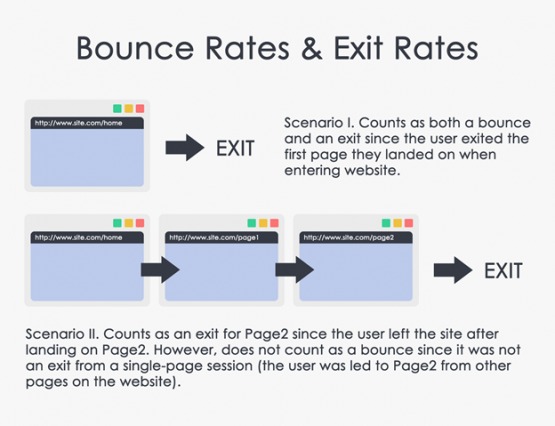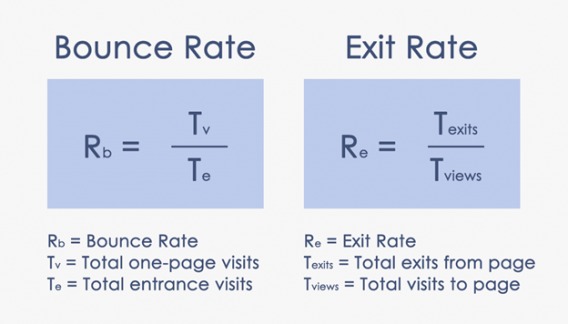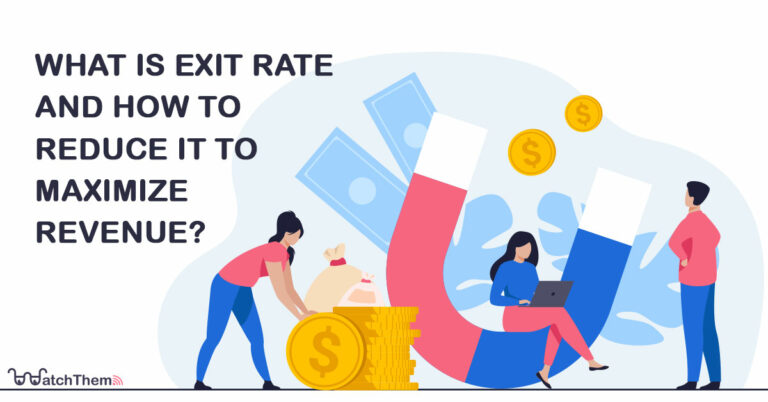Page Contents
There are many website analysis metrics, and most marketers focus on landing page metrics such as the bounce rate. But what about the exit rate? Does it have any benefits for our website to be studied more precisely? Can we find out any information about our customers’ behavior from it? These questions must be answered to understand the importance of the exit rate.
In many cases, business owners would not consider any difference between bounce rate and exit rate. But, here, we discuss exactly what they are and why we should analyze them separately. Where they are acceptable to be high and where not. So, if you need a complete guide on these topics, continue reading and make sure to use the tips we provide.
Click here for more information on marketing strategies.
Difference Between Exit Rate and Bounce Rate
As shown in the picture, the bounce rate can count as the exit rate, but not the other way around.
So, we know the definition now. But is it reasonable to reduce it all the time? The answer is no. A high exit rate is OK for some pages like the thank you page or specific product pages with lengthy and detailed descriptions that require more thought.
To finish this part, let’s see how to calculate these metrics.


As it is shown in the picture, the bounce rate can count as the exit rate, but not the other way around.
So, we know the definition now. But is it reasonable to reduce it all the time? The answer is no. For some pages like the thank you page, or specific product pages with lengthy and detailed descriptions that require more thought, a high exit rate is OK. And it should be.
Now to finish this part, let’s see how to calculate these metrics.


How Can Exit Rate Be Useful?
Now we want to discuss the benefits of the exit rate. First, we should know exactly what the customers’ journey looks like on our websites. Because the questions that the exit rate will answer are different and unique to each one.
Make sure to read this article for more information on customer journey maps.
Here are some of the answers that exit rate can provide us depending on our website journey map:
- Does the page content have a direct impact on visitor conversion?
- Which page is the drop-off point on your website?
- Which specific channels make your visitors leave?
- Are all of the visitors exiting from one specific page or different ones?
Exit Rate Types
While discussing the differences between bounce rate and exit rate, we mentioned that sometimes a high exit rate is acceptable. So, let’s see what our purpose was.
There are two types of exits on a website: natural and unnatural. Here are some examples of when these exits happen:
1. Natural Exits
- Because it is common for a user to end their visit after submitting an inquiry form, the thank you page can have a 100% exit rate.
- A page offering information about a property when purchasing real estate can have a high exit rate. You need more information and a longer thought process compared to buying a flash drive, for example. Leaving is normal because customers need more time and knowledge for their purchases.
2. Unnatural Exits
- Exit (drop-off) can occur on any property category pages, regardless of whether they were accessed directly or via internal navigation/search. Visitors to a category page, like “flats to buy,” are expected to select the size of the flat or their budget range. Then they should look through the listings rather than leaving the site before visiting a page.
- Pages that include forms to complete are another example. Exit on these pages indicates that a user started but never finished submitting your form. In actuality, unless you use an event tracking or a heatmap tool, you won’t detect an exit.
In the natural type, you can see that a higher exit rate is acceptable and causes no problem. But, the problem begins when the exit rate starts to increase on pages where you need customers to stay.
Exit Rate Segmentation
Now that we know exactly where a high exit rate is problematic, it’s time to ask ourselves why. For answering this question, we must segment the exit rate based on different variables. For example, here we name two of them.
1. Devices
Let’s imagine that we have data about our website exit rate. One thing shown there is that the exit rate is noticeably higher than usual on mobile devices. This is an obvious hint for us that there is a problem here. Maybe the website UX is not compatible with mobile devices or something else. Anyway, this can help us to reduce this metric on those devices.
2. Channel
Using some pre-experimental design, we can see the difference between organic and paid traffic. Paid traffic consists of visitors who know what they want and will land on their desired page. On the other hand, organic traffic is visitors who are most likely just searching and comparing products with each other.
Now that we know this, we should consider “Paid Traffic” as our main segment and drill down into our ad groups and keywords (secondary dimension) to identify which keywords are bringing us leads.
Related Article: Top 7 PPC Optimization Tips for 2021
Ways to Investigate and Reduce Exit Rate
There are multiple ways to ensure we have a reasonable exit rate, and it isn’t a problem for our conversion rate. Here we discuss some of them that are more impactful.
1. Using Tracking Tools
To know our exit rate exactly on each page, we need tools to track customers’ behavior and identify their pain points. One of these tracking tools is the WatchThemLive analysis tool, which can be very beneficial. WatchThemLive has two major tools for this purpose. The first one is session replay with which you can see through your customers’ eyes and watch all of their actions one by one and analyze them. The other tool is the heatmap. This tool will let you know which parts of your website attract more attention and have the potential to keep the customers engaged.
If you need more information about these tools, you can start here.
Start using WatchThemLive now! Choose the plan that suits you best and get started for FREE.
2. Improve Your UX
Create a table of contents for your main pages and use subheadings to organize the text. This allows readers to navigate through and find information quickly.
Large blocks of text should be avoided. Instead, short paragraphs should be used to break up your content. Include visual components in your article. Using lists is an excellent method to break down complex material into manageable chunks.
3. Add CTAs in Correct Places
A well-designed webpage must be attractive enough to keep visitors and make them do the activities we want them to do. CTA buttons are essential and should be placed in appropriate places.
4. Different Visual Contents
To engage your visitors and keep them on our websites, we need to entertain them. And this is possible by using multiple types of content like video, picture, voice, and so on. This will lead to more user engagement and increases the average time spent on your website.
5. Optimize the Page Load Time
In today’s era, speed is everything. Too many visual effects can make your website slower. And this will lead to a higher exit rate and fewer conversions. People don’t want to wait for a web page to load as we always are in a rush these days.
Conclusion
As discussed in this article, exit rate is an analysis metric that can be very useful for understanding the whole website’s efficiency. You can use it to improve the overall performance of your website, make your visitors happy, and convert them into loyal customers.


